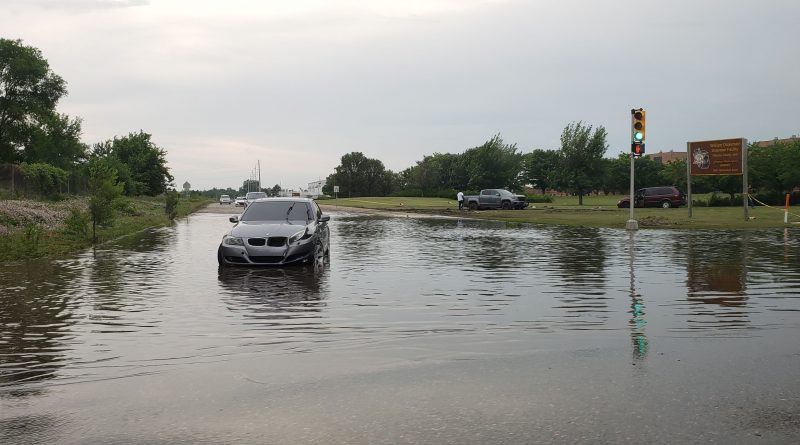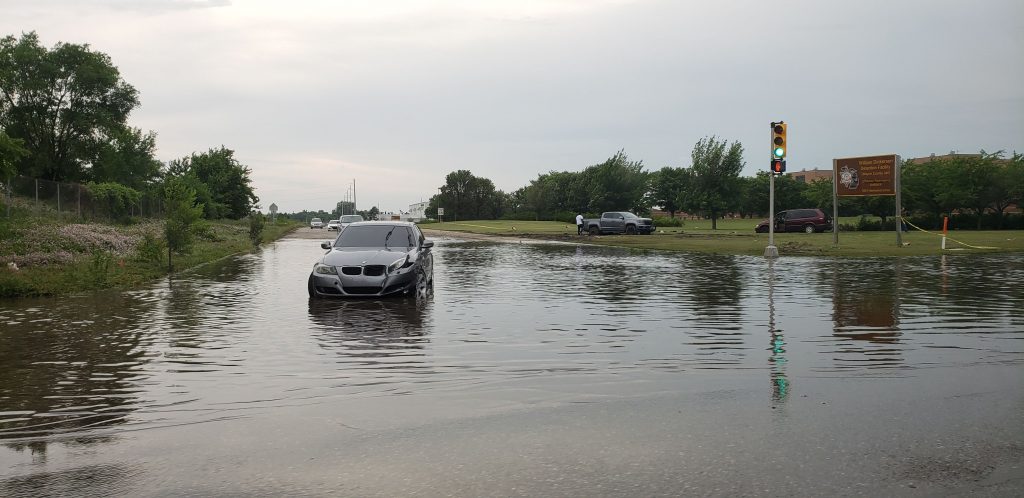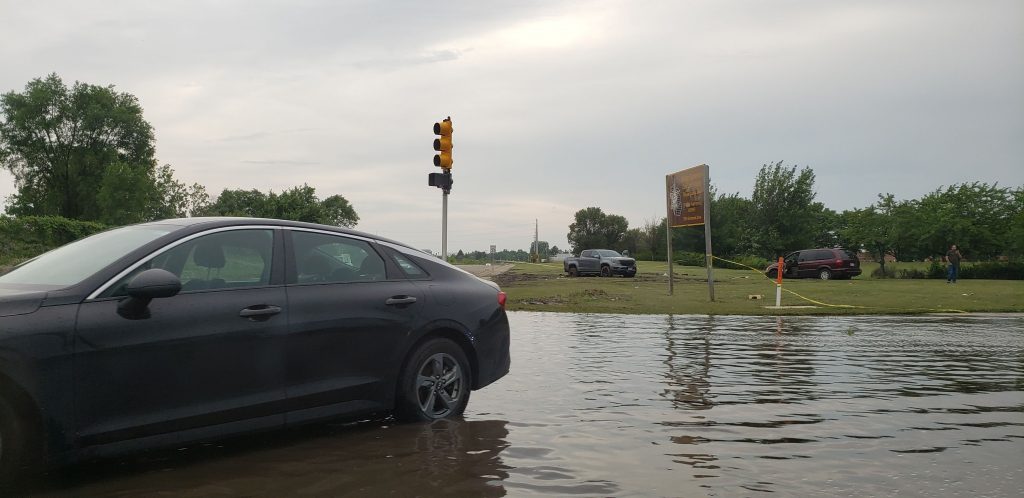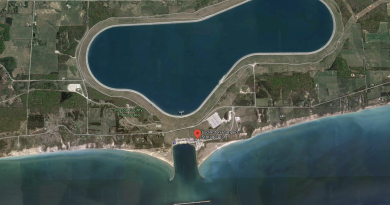If Not Now, When? Detroit Flooding Raises Questions.
Detroit received several inches of rain over Friday evening into Saturday morning. Heavy rain isn’t unusual for a peninsula surrounded by some of the largest lakes in the world; indeed, the state’s record rainfall is around nine inches in a 24-hour period. But the problem with climate change is that records are being broken more and more frequently. Basements have been flooded with rain and backed up sewage. Hundreds of cars across Metro Detroit will soon cross the smog-rainbow bridge to the car afterlife (which is actually just being stuck in a constant NUMTOT feed for eternity being lectured about the virtues of communism and the pitfalls of implicit bias in ableism in infrastructure planning). Is this just business as usual, or is it an extreme thing that we need to acknowledge in planning to revitalize our deteriorated infrastructure? Definitely the latter.
Refresh That Climate Data
According to data from ClimateSpy, Detroit’s warmest and coldest days and months, wettest days, and wettest months, all occurred during the last 48 years. The city went through an extreme drought from the fall of 1942 to the spring of 1943. But recordkeeping goes back way farther. While thermometers themselves go back to roughly the 17th century, with some smart folks thinking it might make sense to actually standardize scales of temperature, recordkeeping is largely a late 19th century, late industrial revolution kind of thing. In the United States, reliable and comprehensive records– the kinds that are easy to tabulate and cross-reference in giant, illustrated charts, I mean- go back to the 1880’s.
Absorb stormwater, rather than constantly trying to work against it. You can’t fight water. The house always wins.
Climate skeptics say that 150 years of data aren’t a large enough sample to suggest that carbon dioxide has a meaningful effect on atmospheric temperatures. In spite of, you know, the fact that we know that it, uh, does. I’m also of the opinion that if your data go back 150 years and the most extreme occurrences in your distribution occur in the last third of the data, you probably should be basing your planning efforts on the last 50 years.
The problem is that, uh, we aren’t. We design things based on the mythic, 100-year flood. But these are happening more often than every hundred years, obviously. The idea of a 500-year flood or a 100-year flood refers to probabilities based on old data. Climate change, we think, is making these things happen more and more often. Flooding in Detroit has happened catastrophically a few times in the past decade. 2014 had a pretty gnarly storm. There have been localized flooding events in dozens of neighborhoods in the past decade.
MDOT’s solution? More concrete! More channels! A giant tunnel under I-75! Is Detroit flooding? The pumps! (The pumps were, well, partially not working).
My solution? Absorb stormwater, rather than constantly trying to work against it. You can’t fight water. The house always wins.
Of Basements & Sewers
Some basics here. Basements flood for two principal reasons: The first is because of water coming in through the foundation walls. Basements, if you’re unaware, generally exist in the first place to provide a space separating the highly absorptive, organic bits of the house itself (N.B. “wood”), from the wet ground. Wood rots when it’s exposed to moisture– and, specifically, the goop and microörganisms in soil.
The second source of basement flooding is from combined sewer overflow. Some cities made the brilliant decision to combine the sanitary sewer (a.k.a. peepee poop-poop) with the storm sewer (excess rainwater). This is fine until your system gets overwhelmed with more flow than it can handle, and suddenly, the gravity and pumping that your system relies on suddenly stops transporting the bad stuff toward the treatment facility, and it backs up in streets and basements. Raw sewage is essentially heavily diluted toilet water, so it’s not going to kill you if you touch it, but it’s definitely toxic and contains all manner of unhealthy things. It also effectively ruins most organic material it touches if that thing cannot readily be sanitized afterward– think old books or photo albums. (Clothes are, for the most part, washable).
Green Stormwater Infrastructure And You
Preventive Measures For Water
There are a lot of preventive measures that can be taken to protect your house, your family, and your stuff in case of extreme weather. I’m listening them here by how involved they are, ranging from DIY to “this is probably going to require a giant machine that moves a lot of earth.” Friendly reminder that Omar and I excavated an entire back yard by hand including fire debris and clay to build our current pervious patio, but this was during early lockdown, and we have vowed to never do something to stupid again. So, use the neat little iconography of how easy something is to do (🛠) and how much protection it will provide (🛡).
- (🛠) (🛡) Elevate your stuff off the floors such that it can’t get wet as easily if your basement floods.
- (🛠) (🛡🛡🛡) Redirect downspouts on the outside of your house. Ensure that they are not directed down into the ground (a.k.a. into the combined sewer). This is already mandated in many municipalities, including Detroit.
- (🛠🛠) (🛡🛡🛡) Install a sump pump in your basement. This is an emergency measure that pumps water from a well into which water collects and basically just ejects it outside.
- (🛠🛠🛠) (🛡🛡🛡) Eliminate hardscaped surfaces around your house.
- (🛠🛠🛠) (🛡🛡🛡) Install a French drain in your yard to channel rainwater away from the house.
- (🛠🛠🛠🛠) (🛡🛡🛡🛡🛡) Install a backwater valve in your basement. This involves busting up concrete and tying into the existing sewer (lateral) line. It is not recommended as a DIY project.
- (🛠🛠🛠🛠🛠) (🛡🛡🛡) Install a green roof if you have a flat roof. This might not work for all structures because green roofs can be heavy. It will, however, absorb water instead of channeling it directly off.
- (🛠🛠🛠🛠🛠) (🛡🛡🛡🛡🛡) Excavate around your whole foundation and waterproof the whole thing.
Remember that there are two issues here– one involves sewage backup and one involves rainwater ingress through foundation walls. The former is something that an individual homeowner’s actions are unlikely to stop, but could be mitigated through, say, neighborhood-wide measures. It’s certainly more of an infrastructure question. But the latter is something that you can personally address.
Alleys: The Back Road To Sustainable Development
Big Picture Solutions
Market-driven solutions. The City of Detroit implemented a drainage tax per parcel, which opponents call a “rain tax.” It’s a cool idea because it disincentivizes maintaining massive fields of surface parking lots. Unfortunately, DWSD still, well, sucks. It’s not responsive to customers. Water mains routinely break, and storm sewer drains clog and flood constantly. Head honcho Gary Brown is literally a cop. So, one can certainly make these complaint of the agency. But the “rain tax” is actually a really good thing because it’s a market-based solution for an ecological problem that has disastrous consequences when Michiganders pave over all of creation to park their Range Rover Fo’Do, or what have you, and just think it’s gonna be OK.
Lending programs to facilitate improvements to foundations and landscaping on private property. Look, people, I don’t have an MBA or anything, but I definitely can do the math and figure out that if it’s going to cost $25,000 per house to improve the foundation and install a backwater valve in the basement, it just might save $25,000 over the next two storms or so. If these storms are happening twice in ten years, well, do the math. This option also comes with pretty wildflowers and hardening our built environment so Detroit’s housing can last through storms or whatever godawful things the next round of municipal austerity and privatization have in store.
Public investment in stormwater-retentive paving. This can begin in alleys, which currently aren’t maintained in most of the city of Detroit. It can also begin in streets. Or wherever the paws of the State can reach, frankly. The city owns a lot of property. It can make sure that sustainable landscaping and water management are, well, trickle-down, as a cultural matter, as opposed to the trickle-down of a leaky roof.
Not super optimistic about the public options in this list, given previous experience, but I’m always excited about the possibilities of them.
Stay dry, Detroit!







